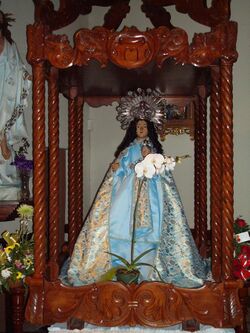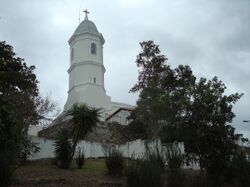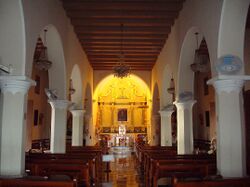Unsolved:Basílica of the Virgin of Monserrat
The Minor Basilica of the Black Virgin of Monserrat El Santuario de la Monserate de Hormigueros and Casa de los Peregrinos[1] | |
 | |
| Location | 1 Calle Peregrinos, Hormigueros, Puerto Rico |
|---|---|
| Coordinates | [ ⚑ ] : 18°08′26″N 67°07′38″W / 18.140676°N 67.127164°W |
| NRHP reference # | 75002134[2] |
| Added to NRHP | April 17, 1975 |
The Basílica of the Black Virgin of Monserrat (Spanish: El Santuario de la Monserrate de Hormigueros and Casa de los Peregrinos) is a historical Roman Catholic shrine built in the town of Hormigueros, Puerto Rico as dedicated to the Blessed Virgin Mary as a Black Madonna under the Marian title of “Virgin of Montserrat”.
Pope John Paul II granted a pontifical decree of canonical coronation titled Omnibus Manifestum towards its venerated Marian image on 18 July 1994. The Archbishop of San Juan, Cardinal Luis Aponte Martínez executed the rite of coronation on 12 February 1995.[3] The same Pontiff issued a decree titled Celeberrimum in Civitate that raised the sanctuary to the status of a minor basilica on 19 May 1998.[4]
History
The foundation of the basilica is on the site of a rural chapel built by the Catalan estate owner Don Gerardo González, who was the owner of the valleys of the region.[5] Although the specific date when the original chapel was constructed is not known, some records date it as far as 1590. Also, radiocarbon dating tests done to pieces of wood from a coffin found in the basilica point to the existence of the chapel as far back as 1570.
The structure combines romantic elements and styles in its architecture, including a bell tower with Mozarabic elements.
In 1696, the chapel acquired a guest house called Casa de Peligrinos (Pilgrims House). In 1814, Juan Alejo de Arizmendi, the first native Puerto Rican bishop, fell ill in this house after traveling around the island in his second pastoral visit.[6] He desired to be buried in his beloved chapel. He died in Arecibo the following October 12, but his wishes were not followed, burial instead taking place in his cathedral. The house is now the rectory of the basilica.
The basilica and its rectory were listed on the National Register of Historic Places in 1975 as the Santuario de la Monserate de Hormigueros and Casa de Peregrinos.[2][1]
On 19 May 1998, Pope John Paul II issued a pontifical decree that raised the status of the structure to a minor basilica, a distinction held previously on the island only by the Cathedral of San Juan Bautista in the capital.
On 24 October 1999, the Archbishop of San Juan, Roberto González Nieves, Roberto González Nieves read the papal decree before the public in commemoration of the shrines 400th centennial anniversary.[7]
Folklore
There is folklore about the town's founder, an explanation of why the church in the town, Basílica Menor de la Virgen de Monserrate, became so important. The legend has to do with the townspeople aiding Geraldo in finding his eight-year-old daughter, "with eyes as blue as the turquoise skies", when she disappeared. When his daughter was found 15 days later she was unharmed, not hungry, and unafraid and happily explained that a beautiful, black woman had helped her, caressed her face and given her fruit. Geraldo reported it was the Virgin of Montserrat and Geraldo said that for having helped his daughter she would be venerated for all ages. Many people heard of the tale but it had not been the first tale from Geraldo.[5] The first and more popular tale from Geraldo had been that a savage bull was going to attack him and when he prayed, the bull bent its knees, bowed its head to the ground, and didn't attack.[8] Some versions of the story state the bull's legs actually broke rendering the bull immobile and unable to charge at him.[9] Since then, many Catholics perform penitence by walking the steps to the church on their knees.[10] Many pilgrimages have been made to the church, even as early as in the 17th century.[5]
See also
- Roman Catholic Diocese of Mayagüez
- National Register of Historic Places in Hormigueros, Puerto Rico
- Latin American miracles
- List of the oldest buildings in Puerto Rico
- Votive offering
References
- ↑ 1.0 1.1 Arturo V. Davila (March 27, 1975). "National Register of Historic Places Inventory/Nomination: Santuario de la Monserate de Hormigueros and Casa de Peregrinos". National Park Service. https://npgallery.nps.gov/NRHP/GetAsset/NRHP/75002134_text. Retrieved January 11, 2022. With accompanying nine photos
- ↑ 2.0 2.1 "National Register Information System". National Register of Historic Places. National Park Service. March 13, 2009. https://npgallery.nps.gov/NRHP.
- ↑ Vatican Secret Archives — Pope John Paul II granted the Pontifical decree of coronation on 18 July 1994, signed and executed by Cardinal Angelo Sodano at the Vatican. Sigillium Vaticanus — Prænotanda Numerorum 353/211.
- ↑ Vatican Secret Archives — Pope John Paul II granted the pontifical decree titled Celeberrimum in Civitate as minor basilica signed and executed by Cardinal Angelo Sodano at the Vatican. Sigillium Vaticanus — Prænotanda Numerorum 433/037.
- ↑ 5.0 5.1 5.2 "Selección de Leyendas puertorriqueñas: El Prodigio de Hormigueros (1640)" (in es). http://ufdc.ufl.edu/UF00078480/00001/37j.
- ↑ The Catholic historical review (1919 ed.). Catholic University of America Press.. 1919. pp. 358. https://books.google.com/books?id=V8htL2FcRjQC&q=Arizmendi++pastoral+visit+puerto+rico&pg=PA358. Retrieved 2009-05-27.
- ↑ "Old church's new status welcomed by Catholics". The Orlando Sentinel: p. 130. October 31, 1999. http://www.newspapers.com/image/236093089/?terms=hormigueros&match=1. "Thousands of Catholics from around the island gathered at the Sanctuary of Our Lady of the Monserrate last weekend to celebrate the papal designation of the 400-year-old church as a Minor Basilica."
- ↑ Ramírez-Rivera, José (1979) (in es). 1929- Selección de Leyendas puertorriqueñas por Cayetano Coll y Toste; adaptación y versión moderna de José Ramírez Rivera; [dibujos, Janet Slemko, Brad Klein] (5th ed.). Mayagüez, P.R.: Ediciones Libero. pp. 92–94. ISBN 978-0-9601700-2-9. https://archive.org/details/selecciondeleyen00rami_0/page/92.
- ↑ Hermandad de Artistas Gráficos de Puerto Rico (1998) (in es). Puerto Rico--arte e identidad. La Editorial, UPR. pp. 96–. ISBN 978-0-8477-0223-7. https://books.google.com/books?id=rP6p1n9jNb8C&pg=PA96.
- ↑ LaBrucherie, Roger (1984). Images of Puerto Rico. El Centro, Calif., USA: Imágenes Press. p. 27.
External links
 |





